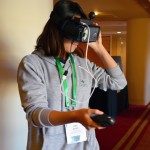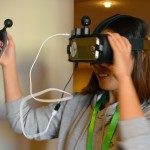Lyrobotix is developing a portable outside-in positional tracking system for mobile VR headsets that uses a combination of ultrasonic and Lighthouse-like tracking.
While big names in the VR space hope to create a robust inside-out positional tracking solution for mobile VR headsets, one company wants to simply reduce the cost and friction of what we already know works well: outside-in tracking.
Lyrobotix, a Beijing-based startup, is building an outside-in tracking system for mobile VR headsets that’s worth keeping an eye on. The system, which works (for now) by attaching a tracking sphere to your VR headset of choice, relies on a single, battery powered emitter which shoots out sweeping lasers as well as ultrasonic pulses to achieve positional tracking. The sweeping laser approach is clearly inspired by Valve’s Lighthouse technology (right down to the design of the emitter), but by my understanding is of Lyrobotix own design rather than a licensing of Valve’s tech.
The lasers and ultrasonic waves are picked up by the small tracking sphere which is covered in receivers. In the prototype demo I saw this week at VRS 2016, the sphere was plugged directly into a Gear VR headset for both power and data relay.
With the emitter placed on a shelf in front of me (which has a supposed 5 hours of battery life), I put on Gear VR and walked the system through its paces. I was presented with a 3D Tetris game where the Tetris pieces were scattered to my left and right, and I had to use the motion controller (built around the same tracking sphere) to put pieces in the right position to win the game. Two controllers are supported, though I only used one during my demo of the prototype.
As I moved my head and body around the tracking space, it responded appropriately to my movements and I didn’t spot any ‘bending’ (where the system thinks I’m moving slightly toward it as I move my head perpendicular to the emitter). With only a single emitter in the front, the tracking space was not room-scale, but felt roughly on par with a front-facing Rift setup (giving me a step or two in any direction).
While the latency of this prototype leaves much to be desired, the accuracy of the system impressed (despite feeling like positional movements were constrained to a grid of small quantized points), and so did its usability. Despite the latency, the tracking was certainly functional, and turning to one side or the other to reach out to grab and manipulate the virtual Tetris pieces really did work. This made me curious about how much potential the system has to improve as it continues to be refined toward a consumer product.
Lisa Zhao, COO of Lyrobotix, told me that the prototype system was not yet fusing IMU data, so the positional tracking I was seeing in the demo was relying entirely on raw data from the emitter and tracking sphere, which only updates at 60Hz. For big headsets out there like the Vive and Rift, the onboard IMU is sampled at very high rates (in the hundreds of Hz) and used to determine the movement of the headset (with the addition of prediction), and then that data is fused with a slower outside-in tracking system to make absolute positioning corrections to prevent drift (much like using GPS coordinates to repeatedly correct small segments of dead reckoning). If Lyrobotix is able to achieve the same sensor fusion with Gear VR’s IMU (and they say they will be able to), it could mean a big improvement over the unfused performance I saw on the prototype (and may also be an answer to the quantized positional behavior I noticed).
I’m still skeptical about the value of combining ultrasonic tracking with Lighthouse-like tracking—after all, it seems like one of the two should be sufficient—and I’ve reached out to the company for clarity on this.
Provided there’s room to reduce the latency, Lyrobotix’s positional tracking solution could be an interesting option. The ease of setup is so simple—place emitter in front of you, turn on switch, put on headset—that it could be a good stopgap until mobile inside-out positional tracking is affordable and widespread, and could even thereafter remain a practical solution for positional tracking on low-end mobile systems.
Zhao says that the company is rapidly moving toward the launch of a development kit of the system. At the beginning of December, Lyrobotix plans to solicit interest in the dev kit and will give a small batch away for free, with following dev kits priced at $100.








